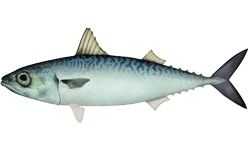Chub Mackerel

Species Details
Scomber Japonicus
Scombridae
Perciformes
Onshore, Nearshore, Offshore, Reef
2 - 4 lbs.
8" - 25"
Chub Mackerel (Scomber Japonicus) Fish Description
The chub mackerel has an elongated and oval-shaped body that tapers at the ends. It has a pointy, small head with a big mouth that has a pronounced lower jaw. It’s generally dark blue and its dorsal color is light green with around 30 blue wavy or zigzagging lines. The underside is silver-yellow to silver-green, with dusky splotches.
It has 2 dorsal fins that are divided, and the space separating them is shorter or equal to the base of the first dorsal fin. They have small scales, which are more prominent around the pectoral fins. The caudal fin is dark gray to black and distinctly forked.
This species is similar to the blue mackerel (Scomber australasicus) and the Atlantic chub mackerel (Scomber colias), but the latter should not be confused with the Atlantic mackerel (Scomber scombrus). The chub mackerel can be determined by the 4-6 finlets on the back and the presence of a swim bladder attached to their esophagus.
Diet
When it’s still in the larvae stage, the chub mackerel feeds on copepods and rotifers (wheel animals) but shifts to zooplankton when it’s a juvenile. Adults feed at night in open waters on small shrimps, amphipods, salps, larvacea, and krill. It’s been known to feed on its own young and that of other fish such as anchovies, sardines, and small herring.
Size
The chub mackerel is a small fish 8-14 inches in length on average. It’s been reported to grow up to 25 inches and weigh 6 lbs. The IGFA All-Tackle world record stands at 4 lbs and 12 oz, caught in Mexico in 1986.
Interesting facts about the Chub Mackerel
- Chub mackerel fossils were found in Italy that were between 2.2 - 3 million years old
- Sometimes called the “hardhead” by fishermen
- Their wavy lines mimic sunlight hitting the water and is camouflage from birds and fish such as yellowfin tuna
- The majority of recipes for this fish come from Indonesia and nearby areas
- Considered kosher and used in Chinese medicine
Fishing Techniques: How to Catch a Chub Mackerel
For anglers, the most common areas to catch this game fish are near the shores around California and Mexico. They are found in sizable numbers inshore from July to November, and offshore from March to May.
It's common in the waters of California south of Point Conception and Monterey Bay. Piers and wharves are great fishing pots and these include Imperial Beach Pier, Newport Pier, Redondo Sportfishing Pier, Stearns Wharf, and Monterey Wharf #2.
The chub mackerel are easy to catch and can be hooked with an ultralight spinning rig such as a 4-pound test. Generally, a medium to light action spinning rod with a 12-15 lb test, and a #2-#4 hook rigged with a small split shot sinker works well.
As for bait, a strip of mackerel, squid, or live anchovy is effective. Small, soft synthetic lures and bright flies are equally effective, especially when this fish is found in schools. Bucktails, mackerel jigs, or roostertail spinners are some good choices.
When fishing for the chub mackerel, the bait should always be kept in motion. Cast out the baited hook, let it sink, and quickly initiate a medium speed retrieve. The chub mackerel will bite the bait when it's moving upward, usually nearer to the surface. It often strikes once before circling to consume the entire bait.
Chub Mackerel Habitat & Distribution
Chub mackerel are widely distributed in the Indo-Pacific. It’s not present in the Indian Ocean, except for South Africa. Its native range in the eastern Pacific is from the coasts of southeastern Alaska to Mexico.
It's a marine subtropical fish, spending its entire life in saltwater at depths up to 984 feet. It's common between 164-656 feet deep, usually about 20 miles from the shore, in temperatures between 50 and 72 degrees Fahrenheit. Juveniles can be found around shores with sandy bottoms or beds of vegetation, particularly kelp. It is a fast grower, can reproduce by 4 years of age, and can live up to 18 years.
The chub mackerel is gregarious and will school both by size and with other species, such as jack mackerel and sardines. Spawning occurs in groups year-round depending on the location. Near Asia, it’s from March to October, whereas in California, it’s April to September. It will move to deeper waters and remain idle during the cooler months.







